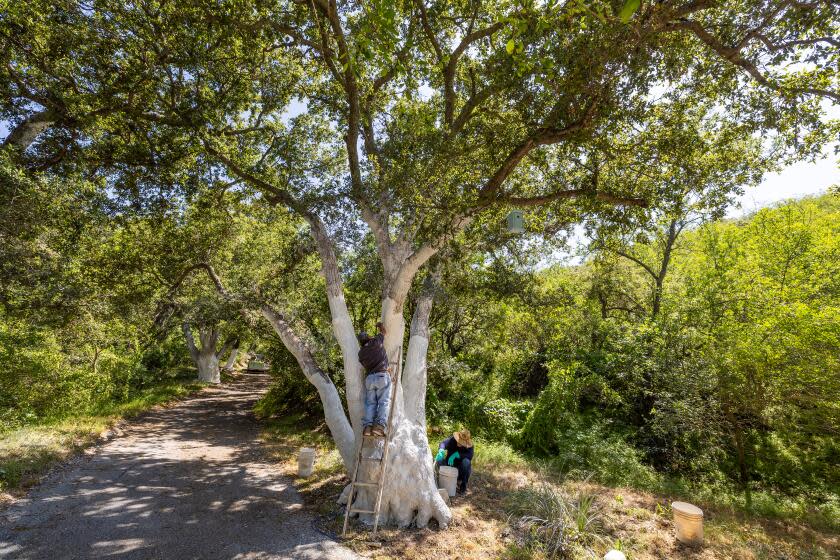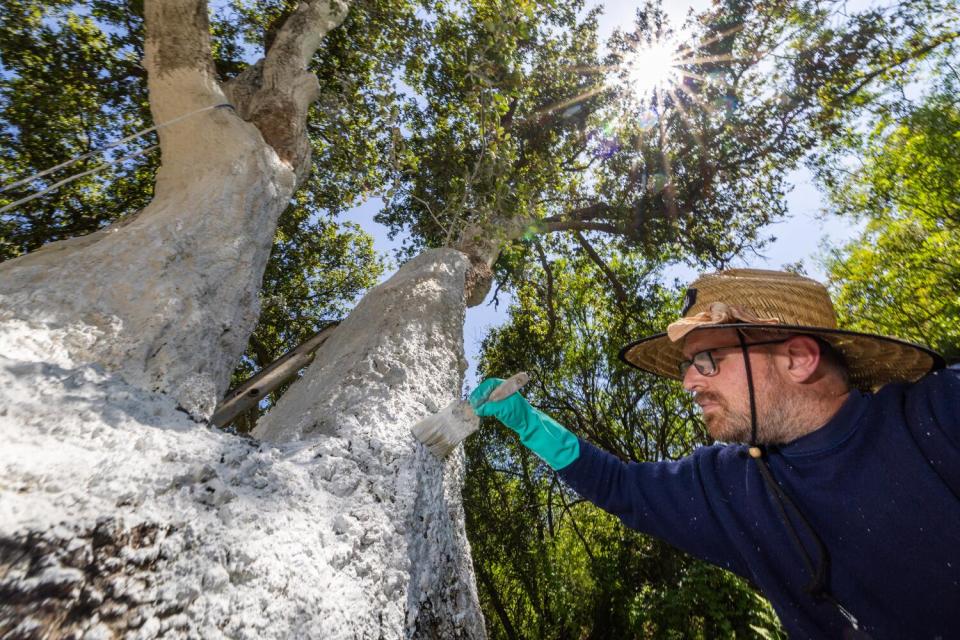Tree-killing beetle is on a death march through Southern California's oaks. Can it be stopped?

The tree was dead.
Ron Durbin, who trekked with a group into a rugged Santa Clarita canyon, quickly spotted nearby trees pockmarked with D-shaped "exit holes," a deadly calling card.
This was the work of the goldspotted oak borer, explained Durbin, forestry division chief for the Los Angeles County Fire Department. And the discovery earlier this year alarmed those who know what this tiny beetle is capable of.
The insects’ presence in East Canyon, along with nearby Rice and Whitney canyons, puts them just 14 miles from the oak-rich Santa Monica Mountains. They were also recently detected in a new area of Silverado Canyon in eastern Orange County.
Durbin described the goldspotted oak borer as "just like a cancer." It has spread across Southern California since its discovery in 2008 in San Diego County, where it has slaughtered more than 80,000 trees. "It's metastasized," he said. "It's stage four."
A coalition of fire officials, land managers, local representatives and pest experts across Southern California are racing to slow the death march — acknowledging that eradication isn’t possible.
Much is at stake.
There are roughly 600,000 coast live oaks in the Santa Monica Mountains. Their demise would spell the loss of shade, wildlife habitat and beauty — and pose significant fire hazards.
On May 7, the L.A. County Board of Supervisors passed a motion to explore declaring a state of emergency and finding funding for additional county Fire Department staffers to tackle the problem. It also calls for drafting regulations on the movement of firewood, which is the vehicle for the beetle's long-distance spread.
"This tiny invasive pest is a big threat," Kathryn Barger, 5th District supervisor and motion coauthor, said in a statement. "I firmly believe our county needs to put its muscle behind proactively protecting our majestic oak forests from infection and death."
Although the goldspotted oak borer’s name strikes the ear as whimsical, it’s actually quite literal. The less-than-one-half-inch beetle is adorned with six gold spots on its back. Larvae hatched from eggs laid on an oak tree bore in to reach the cambium. The cambium is like a tree's blood vessels, Durbin said, carrying water and nutrients up and down. The insect chews through the layer, and eventually the damage is akin to putting a permanent tourniquet on the tree.
An infested tree will often sport a thinning canopy and red or black stains on the trunk, which Durbin said indicate injured areas where the tree is attempting to force out insects. The "confirming sign" is the roughly eighth-inch holes where the adults have chomped through to emerge and mate. The holes are D-shaped. When a tree has 25 or more exit holes, it’s probably a goner, Durbin said. Trees generally die within three years of an incursion.
The insects go only for oaks. In the Golden State, they are attacking the coast live oak, canyon live oak and the California black oak.
The beetle is native to Arizona, where the ecosystem is adapted to it and tree mortality is generally low. It’s believed that it traveled to San Diego County via firewood. By 2012, it took hold in Riverside County. Two years later, it appeared in Orange County. Then, in 2015, it reached Green Valley, an area east of Castaic in L.A. County. Its recent appearance in Santa Clarita represents a 20-mile jump south. About five years after landing in L.A., it was found in San Bernardino County.
It's now present in the mountain towns of Wrightwood and Idyllwild, as well as Great Park in Irvine. Durbin expects it to hit Chatsworth soon.
Firewood sellers are "like dots that connect these infestations," said Rebecca Ferdman, policy director for the L.A. County Chief Sustainability Office. "It's really just a couple of firewood distributors away from the Santa Monica Mountains."
The goldspotted oak borer reaching the scenic coastal mountain range was described as "the worst case scenario for Los Angeles County" in a 2018 report prepared by Durbin.
He and other county officials agree that it will happen. The goal is to buy time.
Why is it such a terrifying prospect? Durbin offered a comparison: Green Valley is home to about 15,000 coast live oaks, and all the recreation, wildlife and habitat — together called ecosystem services — are valued at $449 million. The Santa Monicas, with more than half a million trees, are valued at $17.9 billion.
"Oak trees are essential to the biodiversity of the Santa Monica Mountains, and their health is something we must protect," Lindsey Horvath, L.A. County supervisor and coauthor of the recent motion, said in a statement. Most of the mountains fall within her 3rd District.
The spread there is "more of an issue of when and how quickly, [rather] than whether it will arrive there, and so the intent of all of this activity is really to slow the spread, and to monitor the spread, so that we can be on top of it already when it occurs," Ferdman said.
"Because we know that it's going to cause likely widespread oak tree mortality," she said. “That's going to be devastating for the local ecosystem. It's going to present fire risk, with dead trees abutting developments. It's going to be very expensive to remediate."
By slowing the spread, Ferdman said, the county and other partners can begin planting younger oak trees, which the insect doesn’t target. It could also allow for better treatments to emerge.
The Santa Monica Mountains are probably not the end of the line for the pest; just a devastating pit stop.
Joelene Tamm, a graduate student with UC Riverside’s entomology department who studies the beetle, said researchers have modeled that it could spread all the way through California and into Oregon.
She's concerned with slowing its march north into the Sierra Nevada, where the trees are already contending with the Mediterranean oak borer, another pernicious beetle, and sudden oak death, a disease caused by a microscopic pathogen.
"They got their hands full already," Tamm said. "The more time we have to find an answer ... the better it is in the long term."
Read more: A rare songbird's epic journey from the edge of extinction back to the L.A. River
Many of the potential control methods are just emerging, complicating the battle against the beetle.
When the Green Valley infestation struck, the only option was tree removal. About a year ago, the L.A. County Fire Department started treating certain trees with a systemic pesticide, which is injected into the base. Durbin called the nascent method "promising." Other agencies, such as the U.S. Forest Service, have used a contact spray, which is applied to the outside of the tree, Durbin said. The department has held off on using the spray as it explores the environmental effects, he said.
While pesticides are used "when the situation is right, it’s still expensive to do, still very controversial," Ferdman said.
Some battling the beetle are exploring other options.
Discovering the insect in Big Oak Canyon, a 39-acre property in Silverado Canyon, in January this year "brought us to our knees," said Jodi Levine, executive director of Earthroots Field School, a nonprofit that owns the wilderness site.
That infestation was caught late, Durbin said, so "they're going to lose that ecosystem right there for a long period of time."
By late May, Levine said, they had identified nearly 160 affected trees — some more than 250 years old. About 29 acres of rough country haven't been surveyed yet.

Anxiety and urgency took hold as the nonprofit took in the scope of the predicament. If it didn’t act soon, the beetles would start another destructive life cycle.
But Levine isn’t enthused about the recommended pesticides, which she said have environmental drawbacks. The spray can contaminate waterways and is harmful to aquatic life, while the injectable kills non-target species, such as butterflies and moths, she said.
"It really feels like this ecological dilemma where you're either choosing to let the oak trees die or poison some other aspect of the forest," she said.
So they’re testing a new method. Some trees in Big Oak Canyon are being treated with an experimental nontoxic limewash, while others are receiving pesticides. Heavily infested ones must be felled. The beetles, meanwhile, have started to emerge.
Read more: Mosquito season is upon us. So why are Southern California officials releasing more of them?
UC Riverside's Tamm, also a Squaxin Island Tribal member, said prescribed fire is the only currently available management tool that has potential to be used at a landscape level. Treating trees with insecticide is time-consuming and not always effective, she said, and can’t be done for every tree in the forest.
Prescribed fire is "based on the indigenous land management practices of cultural burning that have been used in California for thousands and thousands of years by the native people," she said, "and it was able to maintain the forest in a healthy manner."
For several years, Tamm has worked alongside the La Jolla Band of Luiseño Indians to research how indigenous cultural burning practices can be used to tackle the oak borer. Some of the preliminary results are promising. For example, Tamm conducted a prescribed burn test by putting pieces of infested wood — some of which had been exposed to fire — into crates and collecting the beetles that emerged. About 330 beetles surfaced from the untreated pieces, while 30 came out of the burned pieces.
Tamm’s other focus is heat-treating firewood to eliminate pests. She hopes her findings will provide a first step toward implementing heat-treatment guidelines for the state.
Lessons learned from the war on the oak borer could be applied to future invaders.
Heat-treating wood, for example, can also help ward off the gypsy moth, spotted lanternfly and the Asian long-horned beetle, Tamm said.
Ferdman expects climate change will usher in more invasive pests, which would create a need for more legislative action. A new reality might require rethinking what she described as mostly reactive responses of the past.
“The creation of some sort of more proactive framework for how different departments that deal with the different facets of invasive pests in different ways could be formalized so that it could be mobilized more efficiently,” she said. “I think that's a need we're going to see in the future.”
Read more: How to protect your trees from invasive beetles killing SoCal's urban forests
This story originally appeared in Los Angeles Times.


